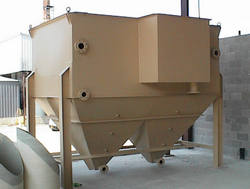Water Treatment
ระบบผลิตน้ำดี และน้ำประปา (Water Treatment System) ระบบกรองน้ำ และระบบผลิตน้ำบริสุทธิ์, ระบบผลิตน้ำสะอาดบรรจุขวด ETPC รับออกแบบและติดตั้งพร้อมจำหน่ายวัสดุอุปกรณ์สำหรับระบบผลิตน้ำดี
Slow & Rapid Mixing Tank
Coagulation is usually accomplished in two stages: rapid mixing and slow mixing. Rapid mixing serves to disperse the coagulants evenly throughout the water and to ensure a complete chemical reaction. Sometimes this is accomplished by adding the chemicals just before the pumps, allowing the pump impellers to do the mixing. Usually, though, a small flash-mix tank provides about one minute of detention time.
After the flash mix, a longer period of gentle agitation is needed to promote particle collisions and enhance the growth of floc. This gentle agitation, or slow mixing, is called flocculation; it is accomplished in a tank that provides at least a half hour of detention time. The flocculation tank has wooden paddle-type mixers that slowly rotate on a horizontal motor-driven shaft. After flocculation the water flows into the sedimentation tanks. Some small water treatment plants combine coagulation and sedimentation in a single prefabricated steel unit called a solids-contact tank.
Suspended particles cannot be removed completely by plain settling. Large, heavy particles settle out readily, but smaller and lighter particles settle very slowly or in some cases do not settle at all. Because of this, the sedimentation step is usually preceded by a chemical process known as coagulation. Chemicals (coagulants) are added to the water to bring the nonsettling particles together into larger, heavier masses of solids called floc. Aluminum sulfate (alum) is the most common coagulant used for water purification. Other chemicals, such as ferric sulfate or sodium aluminate, may also be used.
Slow Mixing & Flocculation is one step in the water and wastewater treatment process. In a flocculation tank, the water is stirred or otherwise moved around so that the particles move around, bump into other particles, and stick to one another. Eventually the small and difficult to remove particles in the water form large clumps which can then be easily removed. Chemicals (most commonly "alum") are often added to the water going into a flocculation tank to help aid particle formation.
Slow Mixing or Flocculation tanks are used to mix polymer and sludge prior to sludge thickening or dewatering. Flocculation tanks are supplied with variable speed agitators, but the speed is very rarely changed during normal operation. Floc tanks generally have an open top, which allows operators to easily visually observe floc conditions. In applications where odors or harmful gases can be present, floc tanks are supplied with a cover. ETPC manufactures floc tanks in numerous sizes to meet the individual needs of each application.






